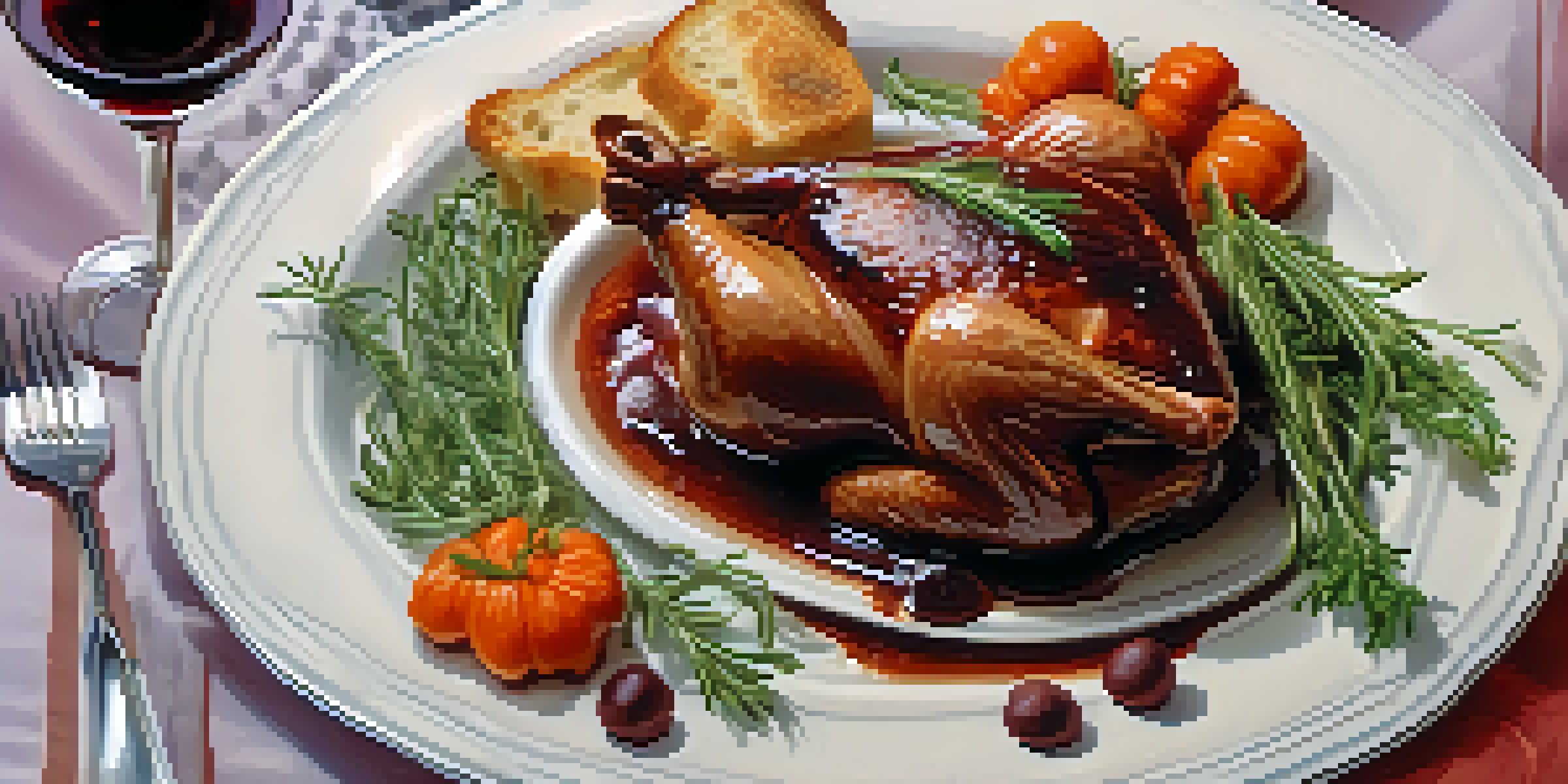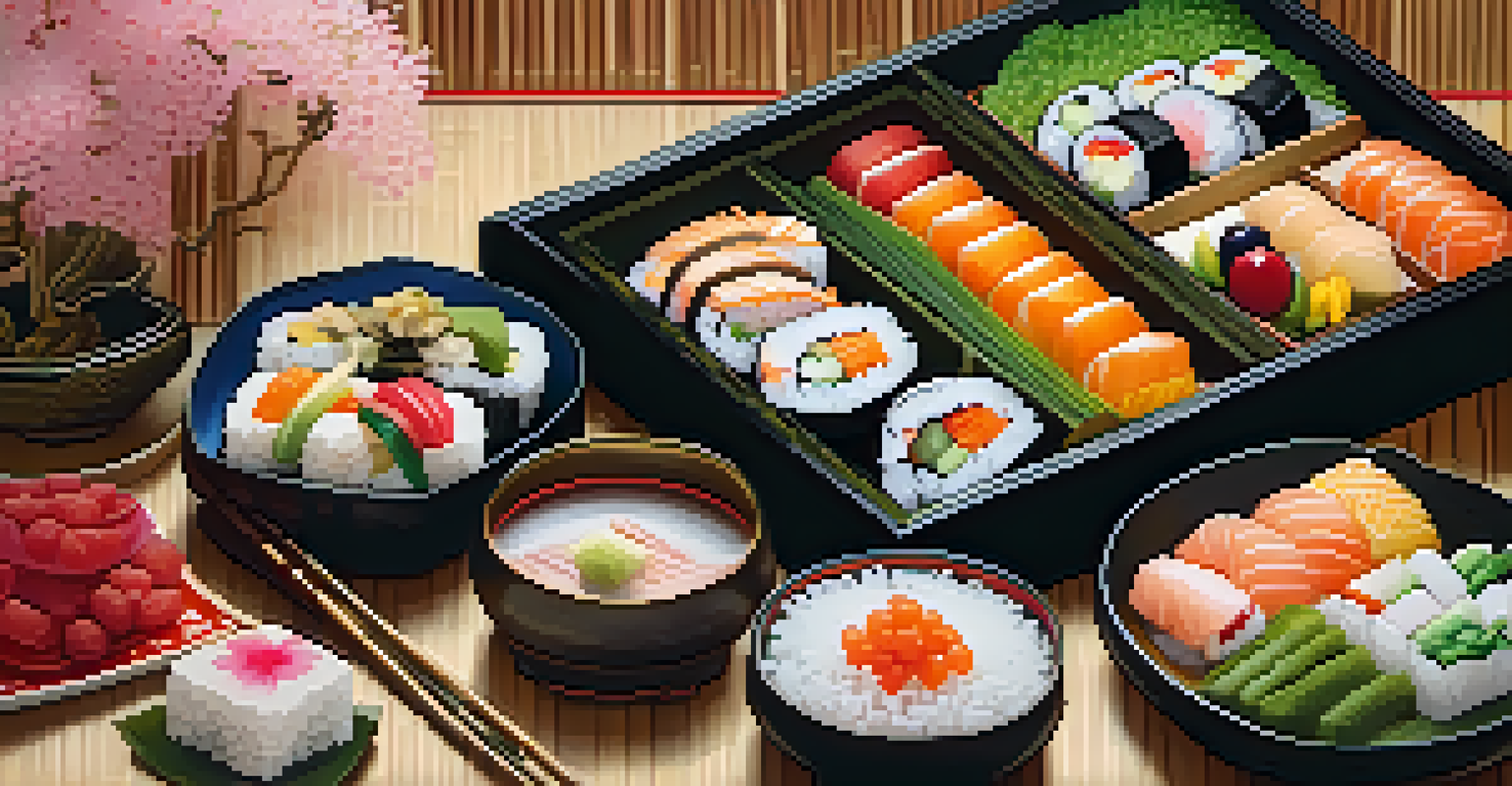Cultural Influences on Food Presentation Across the World

The Role of Culture in Food Presentation
Food presentation is not just about aesthetics; it reflects cultural values and traditions. Different cultures have unique ways of showcasing their culinary creations, often revealing their history and social customs. For instance, in Japan, the concept of 'kawaii' emphasizes cuteness, which is reflected in the careful arrangement of food on the plate.
Presentation is the soul of food; it tells the story of culture and tradition on a plate.
In contrast, Mediterranean cultures often present food in a more communal style, emphasizing shared experiences and vibrant colors. This not only enhances the visual appeal but also fosters a sense of togetherness during meals. Thus, the way food is presented can serve as a window into the cultural identity of a region.
Understanding these cultural influences can deepen our appreciation for global cuisines. When we recognize that a dish's presentation is steeped in tradition, it adds layers of meaning to our dining experience, making it more than just a meal.
Asian Cuisine: Artistry and Minimalism
In many Asian cultures, food presentation is an art form that emphasizes balance and harmony. Take, for instance, the traditional Japanese bento box, where each item is carefully arranged to create a visually appealing and balanced meal. The careful selection of colors, shapes, and textures showcases the artistry involved in preparing food.

Similarly, in Chinese cuisine, the presentation often reflects the season, with dishes decorated to evoke the beauty of nature. Ingredients are not just about taste; their visual appeal plays a significant role in the overall dining experience. This attention to detail highlights a philosophy that values aesthetics as much as flavor.
Culture Shapes Food Presentation
Food presentation reflects cultural values and traditions, providing insight into the identity of a region.
These practices illustrate how Asian cultures integrate presentation into their culinary arts. The beauty of the dish becomes an integral part of the dining experience, inviting diners to appreciate both the visual and gustatory pleasures.
European Elegance and Creativity in Presentation
In Europe, food presentation can vary significantly from country to country but often carries an air of elegance. French cuisine, for instance, is renowned for its intricate plating techniques, where chefs use various garnishes and sauces to create visually stunning dishes. The philosophy of 'haute cuisine' emphasizes not only taste but also the artistry of presentation.
Food is not just what we eat, but how we present it that creates a memorable dining experience.
Italian cuisine, on the other hand, embraces a more rustic approach, showcasing the natural colors and textures of ingredients. A simple pasta dish can be elevated through the careful arrangement of fresh herbs and vibrant vegetables, celebrating the beauty of simplicity. This reflects the Italian love for high-quality, fresh ingredients.
In both cases, the presentation enhances the overall dining experience, making each meal not just about sustenance but also about aesthetic enjoyment. This cultural appreciation for presentation can be seen as a form of artistry that invites diners to engage with their food on multiple levels.
The Influence of Latin American Culture on Presentation
Latin American cuisine is known for its vibrant colors and bold flavors, which are equally mirrored in its presentation. Dishes often feature bright, fresh ingredients that create an eye-catching display, inviting diners to indulge in a feast for the senses. The use of colorful salsas and garnishes adds a celebratory touch to meals, reflecting the region's festive culture.
Moreover, the communal aspect of Latin American dining influences how food is presented. Large platters of food are often placed at the center of the table, encouraging sharing and interaction among diners. This not only creates a visually appealing spread but also fosters a sense of connection and community.
Artistry in Asian Cuisine
Asian cultures emphasize balance and harmony in food presentation, integrating aesthetics into the dining experience.
The cultural emphasis on celebration and togetherness in Latin America is beautifully expressed through food presentation. Each meal becomes an event, with the visual elements playing a crucial role in setting the tone for social interaction and enjoyment.
Middle Eastern Cuisine: A Feast for the Eyes
Middle Eastern cuisine is characterized by its rich flavors and aromatic spices, but its presentation is equally important. Dishes like mezze are often arranged artistically, showcasing a variety of colors and textures that entice the eye. The use of vibrant ingredients such as pomegranate seeds and fresh herbs adds a layer of visual appeal to the dining experience.
Additionally, the tradition of serving food on communal platters encourages sharing and interaction among diners. This presentation style not only enhances the visual aspect but also reflects the cultural value placed on hospitality and togetherness. Sharing food becomes an integral part of the experience, fostering connections between those gathered around the table.
The influence of cultural traditions on presentation in Middle Eastern cuisine highlights how food can serve as a medium for social interaction. The beauty of the dish becomes a celebration of community, inviting diners to savor both the flavors and the shared experience.
Nordic Cuisine: Simplicity and Nature's Bounty
Nordic cuisine, with its focus on fresh, seasonal ingredients, emphasizes simplicity in presentation. The dishes often reflect the natural beauty of the region, using clean lines and minimalistic designs to showcase the quality of the ingredients. This approach aligns with the Nordic philosophy of 'New Nordic Cuisine,' which celebrates sustainability and local sourcing.
For instance, a dish might feature a single, beautifully cooked piece of fish accompanied by foraged herbs and root vegetables, arranged to highlight their natural colors and textures. This style invites diners to appreciate the purity of flavors without unnecessary embellishment, creating a serene dining experience.
Globalization Influences Presentation
As globalization occurs, food presentation styles are merging, leading to innovative fusion dishes that celebrate culinary diversity.
The presentation in Nordic cuisine serves as a reminder of the connection between food and nature. By emphasizing simplicity and quality, it encourages diners to reflect on the origins of their meal and the importance of sustainable practices.
The Globalization of Food Presentation Styles
As the world becomes more interconnected, food presentation styles are evolving through globalization. Chefs and home cooks alike are now experimenting with fusion cuisine, blending elements from various cultural presentations into their dishes. This cross-pollination creates exciting new styles that can surprise and delight diners.
For example, a sushi burrito combines Japanese sushi techniques with the convenience of a burrito, showcasing how different cultures can influence each other. Such innovations not only broaden the culinary landscape but also encourage creativity in presentation, making meals more visually stimulating.

The impact of globalization on food presentation illustrates the dynamic nature of culinary arts. It invites us to embrace diversity and reimagine traditional dishes, all while celebrating the rich tapestry of global cultures that shape our dining experiences.